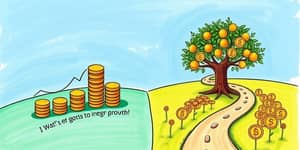
Investors often find themselves at a crossroads when building a portfolio—should they chase rapid expansion or seek hidden bargains? The choice between these two standout strategies, growth and value, influences not only potential returns but also the emotional journey of each market participant. Whether you are saving for retirement, planning for a home purchase or setting up a college fund, understanding how each approach aligns with your personal goals can make all the difference in your investing success. By the end of this guide, you will have the clarity needed to craft a portfolio that resonates with your vision and risk tolerance.
The world of investing is rich with philosophies, but few are as celebrated or debated as growth and value. At their core, they represent two divergent paths—one driven by the momentum of tomorrow’s winners, the other grounded in the pragmatism of today’s bargains. By combining both, investors create a balance that can withstand market cycles and evolving economic landscapes. Beyond mere numbers, this duality offers emotional balance: the confidence of owning established stalwarts and the exhilaration of backing future leaders.
Every investor’s ultimate aim is to build a diversified portfolio for risk management, blending different assets to smooth returns and reduce anxiety. Recognizing where growth and value fit in your overall plan empowers you to navigate market ups and downs with greater conviction and purpose.
Growth Investing zeroes in on companies poised for rapid expansion—those set to outpace the broader market in revenue, earnings and cash flow. Investors in this camp embrace innovation, often placing bets on industries undergoing seismic transformation.
Value Investing seeks companies trading below their perceived intrinsic worth. Value investors meticulously analyze financial statements, asset bases and historical trends, searching for when the market’s pessimism eclipses a firm’s true potential.
Growth investors thrive on momentum. They scour industries for companies with cutting-edge technologies, rapidly expanding market share and visionary leadership. This often means enduring significant price swings, minimal dividends and a willingness to stake capital on potential rather than present-day metrics. Success in growth investing hinges on spotting innovators early and remaining patient through volatility.
Value investors, on the other hand, buy when others shy away. They focus on mature companies with stable cash flows, sound balance sheets and clear business models. Waiting for the market to correct its mispricing requires the discipline to endure extended periods of underperformance. The greatest value triumphs happen when market sentiment shifts, rewarding the disciplined few who held on through the doldrums.
Value investing relies on a toolkit that includes the P/E ratio, price-to-book, free cash flow generation, debt-to-equity and dividend history. These indicators, collectively, help estimate a company’s intrinsic worth, often through models like discounted cash flow or comparable company analysis.
Growth investing metrics tilt toward future performance: revenue and earnings growth rates, PEG ratios (P/E relative to growth), market share trends and reinvestment in research and development. By evaluating both past achievements and forecasts, growth investors gauge whether a company’s trajectory justifies its premium valuation.
Growth stocks carry heightened risk. If companies fail to meet lofty expectations, prices can tumble, erasing gains rapidly. However, when validated by performance, these investments can deliver long-term capital appreciation potential that eclipses market averages.
Value stocks, often offering dividends, represent a more conservative stance. Their returns may compound steadily through dividend reinvestment and eventual price appreciation. Nonetheless, investors must watch for value traps that persist indefinitely, where a low price reflects genuine business struggles rather than mere market oversight.
Over the past half-century, leadership between growth and value has oscillated. The 2010s, fueled by technological innovation and low rates, saw growth dominate. Conversely, periods of high inflation high interest periods have bolstered value stocks, as safety and dividends become paramount.
Most financial advisors recommend a blend, recognizing that each style outperforms in different environments. By balancing growth’s upside potential with value’s stability, investors can smooth returns and reduce the emotional toll of market cycles.
For those who prefer a passive route, growth and value ETFs and mutual funds track specialized indexes, such as the S&P 500 Growth and S&P 500 Value. These products offer instant diversification within each style, making it easy to align your portfolio with your convictions.
Famous advocates embody each philosophy. Growth champions like Cathie Wood and Peter Lynch spotlight innovation and reasonable valuation frameworks. Value titans Warren Buffett and Benjamin Graham have shown how patience and deep analysis can avoid value traps that persist indefinitely and reveal hidden gems as markets recover. Both camps provide lessons that transcend styles, emphasizing research, discipline and emotional resilience.
When deciding between growth and value, consider factors such as:
Ultimately, there is no single right answer. Many investors find peace of mind by combining both approaches, creating a portfolio that captures high anticipated growth expectations while anchoring on steady dividend income and stability. By aligning your strategy with clear objectives and maintaining discipline through market fluctuations, you can navigate financial markets with confidence and purpose.
Growth and value investing each offer compelling advantages and unique challenges. Growth seeks tomorrow’s leaders, offering the thrill of innovation and expansive upside. Value finds tomorrow’s bargains, promising steadier returns and income through dividends. By understanding and blending these philosophies, you gain access to a richer investment palette, finely tuned to your personal goals and risk threshold.
Embrace this knowledge as a compass for your investment journey. Stay curious, remain patient, and harness the power of both growth and value to build a portfolio that stands the test of time.
References













